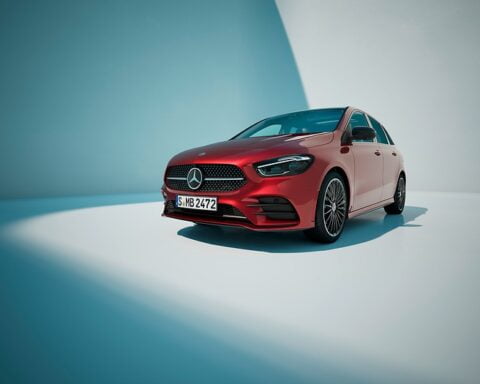Stuttgart. In the autumn of 1961, Mercedes-Benz was, once again, ahead of its time. Only by a few months this time, but the promise it contained was clear: the next spring season was sure to come. The herald of the motoring future for the coming spring was the W 111 luxury class Cabriolet, a direct predecessor of the S-Class, and was unveiled at the International Motor Show (IAA, 21 September to 1 October 1961) in Frankfurt am Main. In addition to the eye-catching design and timeless elegance that never fail to impress the beholder, the open-top vehicle with its four full-featured seats and spacious interior continues to attract attention to this day.
The reason for this abundance of space is that, like the Coupé presented at the Geneva Motor Show in March 1961, the Cabriolet was based on the full-length floor assembly of the “tail fin” Saloon. In this way, the two elegant two-door models also adopted the safety body with crumple zones at the front and rear, as well as the rigid passenger cell. Right from the outset, the Coupé and Cabriolet were planned as members of the W 111 model series. The aim of Chief Engineer and Development Board Member Prof. Dr h.c. Fritz Nallinger was product diversity over a longer period of time – today one would use the term ‘platform strategy’.
Classics that are coveted the world over
The understated elegance underlying the design of both the Coupé and the Cabriolet had perfectly hit the public’s nerve. To this day, both models count among the most beautiful Mercedes-Benz vehicles and are considered to be some of the most sought-after classics worldwide. The designs proved so perfectly timeless that the Coupé and Cabriolet stayed in production for eleven years. In addition, they had a lasting influence on the design of the W 108/109 model series of luxury saloons built from 1965 onwards, and were even built in parallel with them until 1971.
The styling of the two-door variants was the subject of much discussion among the Board and the designers. One point that was considered was an SL front end to emphasise the cars’ sportiness, but this was rejected in favour of the classic design with the Mercedes star mounted on the radiator grille. The radiator grille and front lamp units were, in fact, the only parts carried over from the Saloon.
Take the rear end, for example: officially known as “aiming markers” as a result of their intended function as subtle parking aids on the Saloon, these features were noticeably rounded off for the Coupé and Cabriolet and barely hinted at. Paul Bracq was responsible for the design. The two-door variants were evidently not as high as the Saloon, by 65 mm in the case of the Coupé and 50 mm for the Cabriolet. They were almost identical in length, which meant that the boot was almost exactly the same size as the saloon’s, making these cars also ideal touring vehicles.
In order not to impede large-scale production, the Coupés and Cabriolets were built in Sindelfingen away from normal series production in the special vehicle production unit in Block 32. Many production steps were done by hand. This fact, together with the exclusive character and the high equipment level were reflected in the price: at its premiere in 1961, the 220 SE Coupé was in the price list at DM 23,500 and the corresponding Cabriolet at DM 25,500. By comparison, the “tail fin” 220 SE Saloon cost DM 14,950.
Outstanding aesthetic qualities – inside and out
For this eye-watering price, however, the customer took possession of a mouth-watering car – whether as a Coupé or a Cabriolet. The outstanding aesthetics of the exterior were projected onto the interior. One highlight was the housing of the instrument cluster, which consisted of a single piece of wood of a complex and curved shape, neatly veneered with precious wood in a vacuum so that no joints or edges were visible. Leather upholstery and what was considered to be a sporty central floor selector (the Saloon had a steering column shift) were standard. As an option to the manual four-speed transmission, an automatic transmission with a hydraulic clutch and four-speed epicyclic gear system was also available from 1963. Under the bonnet was the 2.2-litre, six-cylinder M 127 engine with 88 kW (120 hp), familiar from the Saloon. The two-door models were the first Mercedes-Benz vehicles to be fitted with front disc brakes as standard. The 220 SE Coupé and Cabriolet were in production until October 1965 and replaced by the 250 SE Coupé/Cabriolet (M 129, 110 kW/150 hp).
As early as the spring of 1962, Mercedes-Benz expanded its model range to include the 300 SE Coupé/Cabriolet, which were assigned to the W 112 series. Externally, these models were distinguished by chrome strips in the longitudinal beads along the sides of the body and on the wheel cutouts. The upgrade activities on the inside were, however, more significant: a three-litre, six-cylinder M 189 engine with 118 kW (160 hp) and an aluminium engine block, four-speed automatic transmission, air suspension, disc brakes on all four wheels and power steering were all standard equipment. But all this meant the price was now almost DM 10,000 more: the 300 SE Coupé cost DM 32,750 and the Cabriolet DM 34,750, making them the most expensive cars in the model range. From January 1968, the two-door models were available with the 2.8-litre six-cylinder M 130 engine and 118 kW (160 hp) as the 280 SE Coupé/Cabriolet and, from September 1969, a five-speed manual transmission was available.
In November 1969, the Coupé and Cabriolet experienced yet another facelift towards the end of their production time. The top-of-the-range engine was now the new 3.5-litre V8 M 116 engine with 162 kW (200 hp). The new powerhouse was recognisable by a lower-profile bonnet with a wider radiator grille designed exclusively for this engine. The performance was highly appreciated. “auto motor und sport”, for example, enthused in its issue 5/1970: “With this engine, the genteel and somewhat old-fashioned Coupé turned out to be a real surprise: it accelerated from 0 to 100 km/h in 8.9 seconds and topped out at 215 km/h.”
Production of the Coupés and Cabriolets of the W 111 and W 112 model series ended in July 1971. A total of 28,918 of the Coupés were produced, and a further 7013 Cabriolets. To this day, these cars have retained their nobility: anyone who owns one of these exclusive two-door cars can count themselves lucky.






